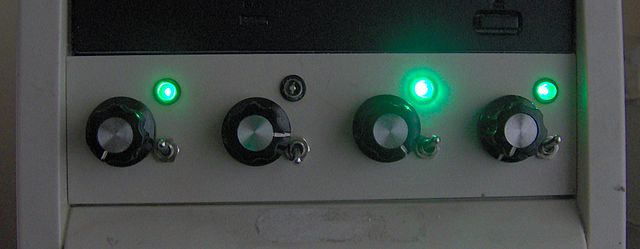Fan control is the management of the rotational speed of an electric fan. In computers, various types of computer fans are used to provide adequate cooling, and different fan control mechanisms balance their cooling capacities and noise they generate. This is commonly accomplished by the motherboards having hardware monitoring circuitry, which can be configured by the end-user through BIOS or other software to perform fan control.
Full-tower computer cases may contain multiple cooling fans. At the top of the case is a fan controller.
SMSC EMC2102 rotational-speed-based fan controller with hardware thermal shutdown
A fan controller with LEDs indicating fan status and potentiometers and switches to control fan speeds
A computer fan is any fan inside, or attached to, a computer case used for active cooling. Fans are used to draw cooler air into the case from the outside, expel warm air from inside and move air across a heat sink to cool a particular component. Both axial and sometimes centrifugal (blower/squirrel-cage) fans are used in computers. Computer fans commonly come in standard sizes, such as 92 mm, 120 mm, 140 mm, and even 200–220 mm. Computer fans are powered and controlled using 3-pin or 4-pin fan connectors.
A 3D illustration of six 80 mm fans, a type of fan once commonly used in personal computers (sometimes as a set, or mixed with other fan sizes)
A 30-millimetre (1.2 in) PC fan laying atop one sized 250 mm (9.8 in)
An 80×80×25 mm axial computer fan
Fans from computer case – front and back







